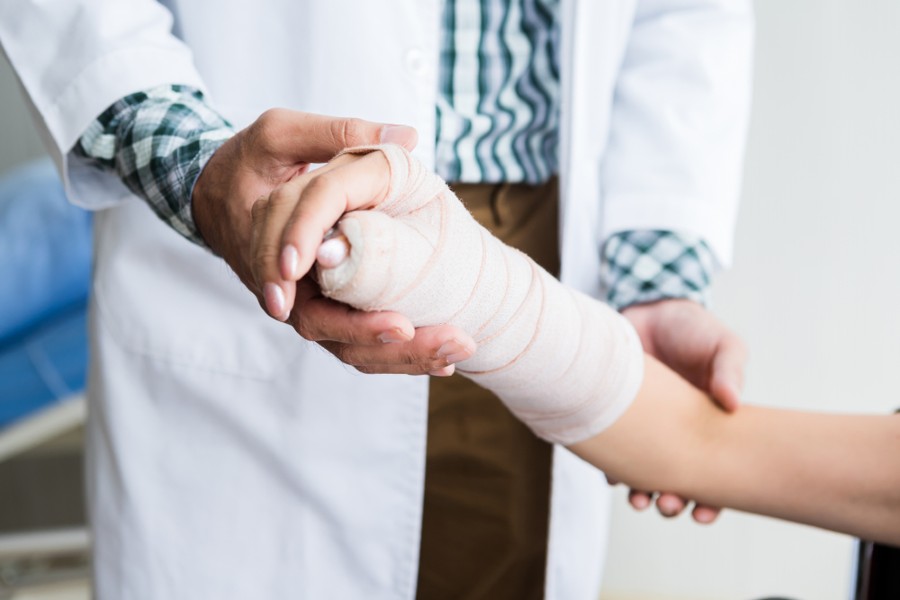How Long Does It Take To Heal A Fractured Hand – A Complete Guide!
A fractured hand typically heals in 4 to 8 weeks, depending on the severity. Proper treatment, rest, and rehabilitation are essential for a full recovery.
In this article, we’ll explore how long it takes for a fractured hand to heal, the factors that affect recovery, and tips for a successful rehabilitation.
Factors Affecting Healing Time:

The healing time for a fractured hand varies depending on several factors. These include the severity of the fracture, the type of fracture (whether it’s a simple or complex fracture), and the treatment required.
Severity of the Fracture:
A minor fracture with little displacement of the bone will heal faster than a more severe fracture where the bone is displaced or broken into multiple pieces. Severe fractures often require surgery and a longer recovery period.
Type of Fracture:
There are different types of fractures, such as stable, unstable, open, or closed fractures. Closed fractures, where the bone does not pierce the skin, tend to heal faster than open fractures, where the bone breaks through the skin and increases the risk of infection.
Treatment:
The type of treatment provided plays a crucial role in healing. A simple fracture may require just a cast, while more complex fractures may need surgical intervention. Surgery usually involves the insertion of plates, screws, or pins to stabilize the bone, which can extend the healing time.
Age and Health:
Young, healthy individuals tend to heal faster than older adults, as they have better blood circulation and cell regeneration. Pre-existing conditions like osteoporosis or diabetes can slow down the healing process and may require additional medical attention to ensure proper recovery.
Also Read: Sante Center For Healing – Holistic Healing Center!
Stages of Healing a Fractured Hand:
The healing process of a fractured hand generally involves three main stages. These stages ensure the fracture heals properly and that the hand regains its full range of motion.
Inflammatory Phase (0-7 Days):
The first stage begins immediately after the injury. During this phase, the body focuses on controlling bleeding, reducing inflammation, and forming a blood clot at the fracture site. Swelling and bruising are common in the initial few days. This phase is essential for laying the groundwork for proper bone healing.
Repair Phase (1-6 Weeks):
During the repair phase, the body begins to generate new bone tissue to bridge the gap between the fractured bone ends. A soft callus forms around the break, which eventually becomes hard bone. This phase typically lasts for 1 to 6 weeks, depending on the severity of the fracture. Immobilization of the hand using a cast or splint is crucial during this time to ensure proper alignment of the bones.
Remodeling Phase (6 Weeks to Several Months):
In the final phase, the body continues to strengthen the new bone tissue, making it more resilient and aligned. During this phase, the cast or splint may be removed, and physical therapy can begin to restore movement and strength to the hand. This phase can last several months, and rehabilitation is crucial to prevent stiffness and regain full function.
Rehabilitation and Recovery:

Once the bone has healed sufficiently, rehabilitation becomes essential to restore strength, mobility, and function. Depending on the severity of the fracture, physical therapy may be recommended to help regain full use of the hand.
Range of Motion Exercises:
In the first few weeks after the cast is removed, gentle exercises may be prescribed to improve flexibility and prevent stiffness in the joints. These exercises gradually increase in intensity as the hand becomes stronger.
Strengthening Exercises:
As healing progresses, strengthening exercises can help rebuild muscle strength and improve hand function. These exercises are essential for restoring grip strength and overall dexterity, especially if the fracture involved the fingers or wrist.
Avoiding Re-Injury:
During the rehabilitation phase, it is essential to avoid activities that could risk re-injuring the hand. Gradual return to normal activities is advised, with careful monitoring of any pain or discomfort.
Also Read: Can Chlamydia Heal On Its Own – Here’s What You Need to Know!
How to Speed Up the Healing Process:
While healing from a hand fracture is a gradual process, there are several ways to speed up recovery and promote healing. First and foremost, following your doctor’s advice is crucial. Additionally, the following tips can help:
- Maintain a Healthy Diet: Eating foods rich in calcium and vitamin D, such as dairy products, leafy greens, and fish, can support bone healing. Proper nutrition is essential for strengthening bones and supporting the body’s recovery.
- Rest and Elevation: Proper rest is vital to ensure the body focuses on healing. Elevating the hand above heart level can help reduce swelling and promote circulation, speeding up the recovery process.
- Follow Medical Instructions: Whether it’s wearing a cast or attending physical therapy sessions, following your healthcare provider’s instructions is crucial. This will ensure that the fracture heals in the correct position and that you regain full use of the hand.
Complications to Watch For:
While most hand fractures heal without issues, there are potential complications that can extend the healing time. These include:
- Infection: Open fractures are more prone to infection because the bone is exposed to the environment. Infections can significantly delay the healing process and may require additional medical treatment, such as antibiotics or even surgery.
- Non-Union or Malunion: In some cases, the bones may not heal properly, leading to non-union (where the bones fail to heal together) or malunion (where the bones heal incorrectly). These conditions may require additional treatment or surgery to correct.
- Joint Stiffness or Loss of Function: In cases where the hand is immobilized for a long period, there can be stiffness or a loss of function in the fingers and wrist. Physical therapy is critical to restoring mobility and strength after the fracture has healed.
FAQ’s
1. How long does it take to heal a fractured hand?
It generally takes 4 to 8 weeks for a fractured hand to heal, depending on the severity of the fracture and the treatment received.
2. Do I need surgery for a fractured hand?
Surgery is required for severe fractures, especially when the bone is displaced or shattered. For less severe fractures, a cast and rest may suffice.
3. Can I use my hand while it’s healing?
You should avoid using the hand for heavy tasks during the healing phase. Light use may be allowed as the fracture heals, but always follow your doctor’s advice.
4. What can I do to speed up healing?
Maintaining a healthy diet rich in calcium, ensuring adequate rest, and following medical instructions can help speed up recovery.
5. When can I return to normal activities after a hand fracture?
The timeline for returning to normal activities varies depending on the severity of the fracture. Most people can resume normal activities within 8 to 12 weeks, but some may require longer for full recovery.
Conclusion
The healing time for a fractured hand varies based on the severity of the injury, treatment, and individual factors. With proper care, most fractures heal within 4 to 8 weeks. Following medical advice, maintaining a healthy lifestyle, and engaging in rehabilitation exercises are key to ensuring a full recovery and regaining hand function.






